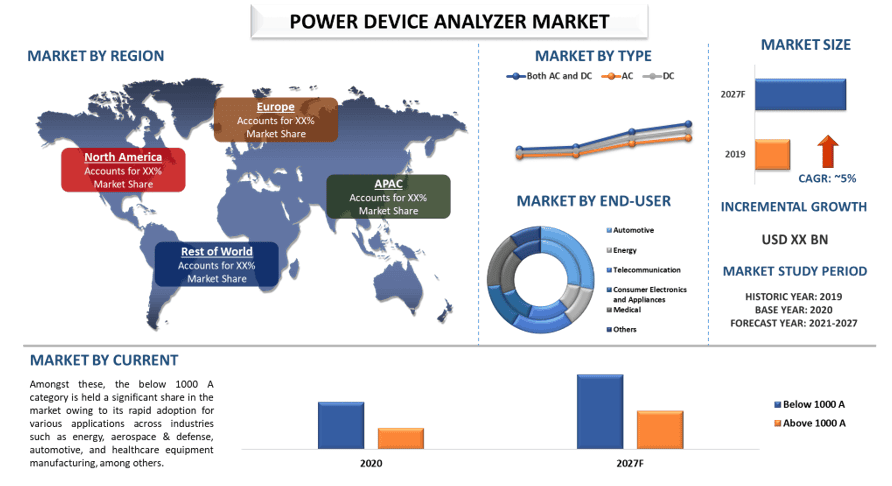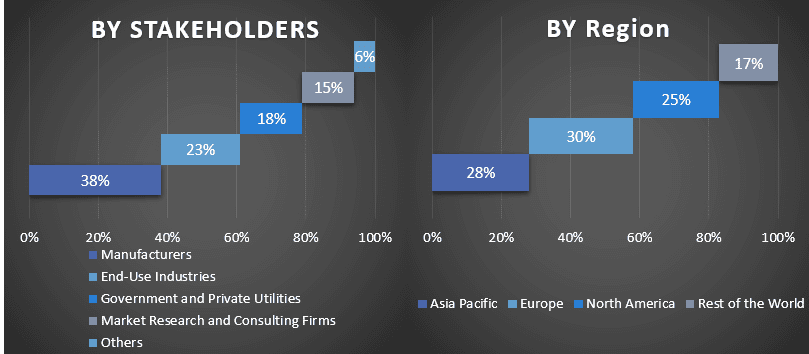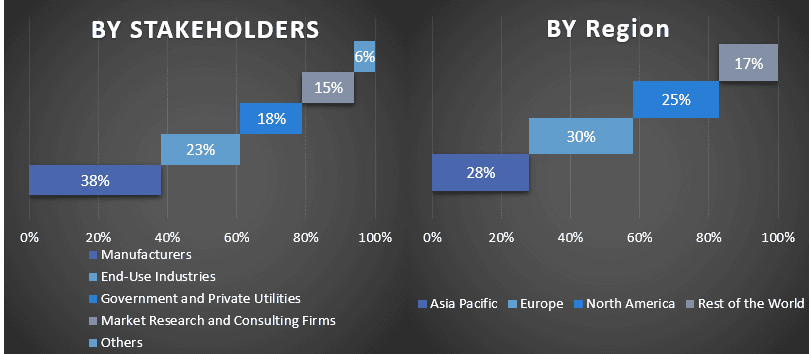Emphasis Type (Both AC and DC, Alternating Current, and Direct Current); Current (Below 1000 A and Above 1000 A); End-User (Automotive, Energy, Telecommunication, Consumer Electronics and Appliances, Medical, and Others); and Region/Country

The power device analyzer market has captured significant market demand and is expected to grow at a CAGR of 5% during the forecast period. This is mainly due to increasing digitization in the utility sector coupled with the rising demand for uninterrupted power supply from the residential and industrial sectors. In addition, the growing renewable energy sector is further expected to drive the demand for power device analyzers during the forecast period. In the wind power sector, power device analyzers are widely being adopted for testing purposes. Wind turbines have to comply with many regulations, including power regulations. Thus, many companies offer comprehensive power testing solutions through their power device analyzers. It measures current, voltage, active power, and energy being provided by a wind-powered generator.
COVID-19 has slowed the growth of the power device analyzer, as countries were forced to implement lockdowns during the first half of 2020. Many activities were halted during the lockdown, including mobility, economic activity, construction, and manufacturing. Furthermore, COVID-19 impacted the operations of the power device analyzer market players and also affected the businesses of companies from the end-use industries.
Keysight Technologies Inc., Yokogawa Electric Corporation, Fluke Corporation, Rohde & Schwarz GmbH & Co KG, Carlo Gavazzi, Iwatsu Electric Co. Ltd., Hioki E.E. Corporation, Newtons4th, Vitrek Corporation, and Texas Instruments Inc. are some of the key players in the market. Several strategic measures have been undertaken by these players to facilitate customers with hi-tech and innovative products/technologies.
Insights Presented in the Report
“Amongst type, both AC and DC category is expected to witness considerable growth during the forecast period”
Based on type, the market has been categorized into Both AC and DC, alternating current (AC), and direct current (DC). Amongst these, both AC and DC category is expected to witness significant growth during the forecast period. This is mainly due to the increasing advancements and dependability of advanced systems to support the integration of power generation and distribution from renewable sources in the overall energy sector as well as the increase in demand for continuous energy supply across geographies and industries. Furthermore, increasing consumption of electricity due to an increasing population, followed by an increasing number of consumers and rapid urbanization, has led to the growth of power device analyzers across the globe.
“Amongst current, below 1000 A category held a significant share in 2020”
Based on the current, the market has been categorized into below 1000 A and above 1000 A. Amongst these, the below 1000 A category is held a significant share in the market owing to its rapid adoption for various applications across industries such as energy, aerospace & defense, automotive, and healthcare equipment manufacturing, among others. Furthermore, as vehicle technology continues to advance in the areas of safety, environmental friendliness, and comfort, major stakeholders in the market continue to develop advanced systems to support the increasingly complex electronic vehicle components, systems, and innovations. For instance, the SB5000 Vehicle Serial Bus Analyzer by Yokogawa Electric Corporation is a tool for engineers involved in the development and use of in-vehicle communication buses. It diligently provides up-to-the-minute technologies and analyzers for safety systems (ABS, airbags), drivetrain performance, ECU, and various others.
“Amongst end-user, automotive to lead growth in the global power device analyzer market”
Based on end-user, the market is classified into automotive, energy, telecommunication, consumer electronics and appliances, medical, and others. In 2020, the automotive category accounted for a significant share in the market owing to In addition, in an electric vehicle, power device analyzers can be used to test various components, such as electric motors, battery management systems, navigation systems, and electrical charging systems.
“APAC to witness significant growth during the forecast period”
Asia Pacific holds a lucrative market share owing to favorable government policies and a growing focus on increasing the share of renewable energy in the power generation mix are some of the prominent factors driving the region’s market. For instance, in 2021, China’s total renewable energy capacity increased 10.2 percentage points as compared to 2015. The capacity exceeded 1,000 GW in 2021, according to the National Energy Administration, accounting for 43.5% of the country’s total power generation capacity. Further, growing investments in the up-gradation of old equipment, the growing development of smart cities coupled with increasing industrialization in different countries of the region. The region is expected to dominate during the forecast period as the region is a hub for manufacturing electronics components and devices corresponding to various industries.
Reasons to buy this report:
Customization Options:
Global power device analyzer market can further be customized as per the requirement or any other market segment. Besides this, UMI understands that you may have your own business needs, hence feel free to connect with us to get a report that completely suits your requirements.
1. Market Introduction
2. Research Methodology Or Assumption
3. Market Synopsis
4. Executive Summary
5. Impact Of Covid-19 On The Power Device Analyzer Market
6. Power Device Analyzer Market Revenue (usd Bn), 2019-2027f
7. Market Insights By Type
8. Market Insights By Current
9. Market Insights By End-user
10. Market Insights By Region
11. Power Device Analyzer Market Dynamics
12. Power Device Analyzer Market Opportunities
13. Power Device Analyzer Market Trends
14. Demand And Supply-side Analysis
15. Competitive Scenario
16. Company Profiled
17. Disclaimer
Analyzing the historical market, estimation of the current market, and forecasting the future market of the global power device analyzer market were the three major steps undertaken to create and analyze the adoption of power device analyzers in major regions globally. Exhaustive secondary research was conducted to collect the historical market numbers and estimate the current market size. Secondly, to validate these insights, numerous findings and assumptions were taken into consideration. Moreover, exhaustive primary interviews were also conducted, with industry experts across the value chain of the global power device analyzer market. Post assumption and validation of market numbers through primary interviews, we employed a top-down/bottom-up approach to forecasting the complete market size. Thereafter, market breakdown and data triangulation methods were adopted to estimate and analyze the market size of segments and sub-segments of the industry pertains to. Detailed methodology is explained below:
Seek More Details About Research Methodology
Analysis of Historical Market Size
Step 1: In-Depth Study of Secondary Sources:
Detail secondary study was conducted to obtain the historical market size of the power device analyzer market through company internal sources such as annual reports & financial statements, performance presentations, press releases, etc., and external sources including journals, news & articles, government publications, competitor publications, sector reports, third-party database, and other credible publications.
Step 2: Market Segmentation:
After obtaining the historical market size of the power device analyzer market, we conducted a detailed secondary analysis to gather historical market insights and share for different segments & sub-segments for major regions. Major segments included in the report as current, type, and end-user. Further country-level analyses were conducted to evaluate the overall adoption of testing models in that region.
Step 3: Factor Analysis:
After acquiring the historical market size of different segments and sub-segments, we conducted a detailed factor analysis to estimate the current market size of the power device analyzer market. Further, we conducted factor analysis using dependent and independent variables such as various current, type, and end-user of power device analyzer equipment. A thorough analysis was conducted for demand and supply-side scenarios considering top partnerships, mergers and acquisitions, business expansion, and product launches in the power device analyzer market sector across the globe.
Current Market Size Estimate & Forecast
Current Market Sizing: Based on actionable insights from the above 3 steps, we arrived at the current market size, key players in the global power device analyzer market, and market shares of the segments. All the required percentage shares split, and market breakdowns were determined using the above-mentioned secondary approach and were verified through primary interviews.
Estimation & Forecasting: For market estimation and forecast, weights were assigned to different factors including drivers & trends, restraints, and opportunities available for the stakeholders. After analyzing these factors, relevant forecasting techniques i.e., the top-down/bottom-up approach were applied to arrive at the market forecast about 2027 for different segments and sub-segments across the major markets globally. The research methodology adopted to estimate the market size encompasses:
Market Size and Share Validation
Primary Research: In-depth interviews were conducted with the Key Opinion Leaders (KOLs) including Top Level Executives (CXO/VPs, Sales Head, Marketing Head, Operational Head, Regional Head, Country Head, etc.) across major regions. Primary research findings were then summarized, and statistical analysis was performed to prove the stated hypothesis. Inputs from primary research were consolidated with secondary findings, hence turning information into actionable insights.
Split of Primary Participants in Different Regions

Market Engineering
Data triangulation technique was employed to complete the overall market estimation and to arrive at precise statistical numbers of each segment and sub-segment of the global power device analyzer market. Data was split into several segments & sub-segments post studying various parameters and trends in the areas of current, type, and end-user in the global power device analyzer market.
The main objective of the global power device analyzer Market Study
The current & future market trends of global power device analyzer market were pinpointed in the study. Investors can gain strategic insights to base their discretion for investments from the qualitative and quantitative analysis performed in the study. Current and future market trends were determined the overall attractiveness of the market at a regional level, providing a platform for the industrial participant to exploit the untapped market to benefit as a first-mover advantage. Other quantitative goals of the studies include:

Customers who bought this item also bought